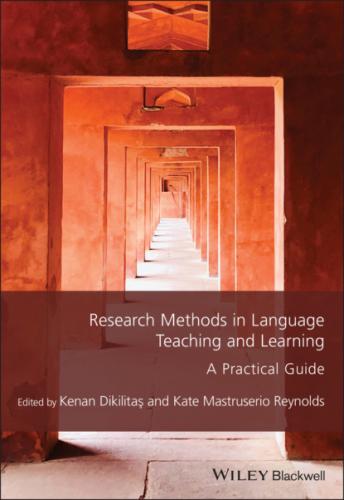Relatedly, in Chapter 13, “Using Mixed Methods Design to Investigate Vocabulary Acquisition,” Andrea B. Hellman introduces her narrative portraying how she explored vocabulary acquisition using methods that belong to both quantitative and qualitative paradigms, revealing key justifications and procedures she followed closely to ensure rigor in methodological practices. It is evident that there are controversial attitudes towards investigating a research phenomenon adopting two paradigms. However, sharing her own contextualized experiences, Hellman also provides profound details that could set a methodological model for researchers interested in using mixed methods in applied linguistics to consider.
We recognize that research studies involving only quantitative research are less common in the field. We invited three key contributions to our book that follow only quantitative research methods, including data collection tools and data analysis. For example, in Chapter 14, “Correlational Analysis in SLA: Insights From the Study Abroad Research,” Zeynep Köylü introduces correlation analysis as a quantitative method that is adopted to investigate the phenomenon of study abroad as a specific topic in second language acquisition. Throughout her chapter, Köylü provides step-by-step implementation of correlation analysis by highlighting the key methodological considerations that emerged from her research experiences. The chapter incorporates unique researcher reflections on fundamental decisions that could help others implementing this analysis in their research studies in applied linguistics and encourage more researchers to undertake this research approach.
On the other hand, in Chapter 15, “Conducting a Non-Experimental Design Quantitative Study and the Application of Partial Least Squares Structural Equation Modeling,” as an alternative to univariate and bivariate analysis including correlation, Hilal Peker introduces a second-generation analysis technique: structural equation modeling. Peker justifies the methodological advantages and the potential to generate hypotheses and theories rather than testing existing hypotheses by adopting structural equation modeling. She provides an in-depth narrative on her actual experiences using this model with clear corresponding examples from her published research.
In Chapter 16, “Behind the Scenes of a Longitudinal Large-Scale Randomized Controlled Trial Study with Native Spanish Speakers: Lessons Learned,” Rafael Lara-Alecio, Beverly J. Irby, Fuhui Tong, Cindy Guerrero, Kara L. Sutton-Jones, and Nahed Abdelrahman narrate their experiences in using longitudinal large-scale randomized controlled trial studies in which they compared transitional bilingual education and structured English immersion in kindergarten. The researchers depict the key methodological experiences to reveal potential challenges and opportunities in such a broad collaborative research process with a large participant group.
We also included two chapters that can be categorized as systematic review characterized as research on published research. In Chapter 17, “Quantitative Systematic Reviews: A Lived Experience,” Tamara Kalandadze recounts her actual methodological experiences with planning and conducting two of her systematic reviews that draw on published quantitative studies. She introduces emerging challenges and opportunities alike, which could help others interested in learning to write systematic reviews purely based in the quantitative paradigm particularly in the area of language and communication.
Comparably, in our final chapter, “Exploring the (Un‐)Explored in Applied Linguistics: Conducting a Systematic Review in Intercultural Communicative Competence,” Maria losifina Avgousti narrates her methodological research experiences with conducting a systematic review of a topics drawing on published qualitative research studies. In her published research she reviewed qualitative studies that investigated intercultural communicative competence within the scope of language learning and teaching. She highlights key considerations in reviewing qualitative studies to generate generalizable knowledge for the area of research.
Compiling a wide range of topics that have been investigated by means of various research methods, the book offers a narrative description of in-depth experiences of researchers with the purpose of providing research knowledge. We hope that the contributions could shed light on others’ research processes who set out to learn research methodology in the field of applied linguistics.
We now invite you to pull up a chair with coffee or tea in hand and listen to your peers share their research processes…
References
1 Burnett, P. C. (1999). The supervision of doctoral dissertations using a collaborative cohort model. Counselor Education and Supervision, 39(1), 46–52. https://doi.org/10.1002/j.1556-6978.1999.tb01789.x
2 Carter, P. D. (2010). Using action methods in post-graduate supervision. International Journal of Education & the Arts, 11(1), n 1. http://www.ijea.org/v11n1/
3 De Haan, E. (2011). Relational coaching: Journeys towards mastering one-to-one learning. John Wiley & Sons.
4 Earley, M. A. (2014). A synthesis of the literature on research methods education. Teaching in Higher Education, 19(3), 242–253. https://doi.org/10.1080/13562517.2013.860105
5 Fillery-Travis, A., & Robinson, L. (2018). Making the familiar strange: A research pedagogy for practice. Studies in Higher Education, 43(5), 841–853. https://doi.org/10.1080/03075079.2018.1438098
6 Hagström, L., & Scheja, M. (2014). Using meta-reflection to improve learning and throughput: Redesigning assessment procedures in a political science course on power. Assessment & Evaluation in Higher Education, 39(2), 242–252. https://doi.org/10.1080/02602938.2013.820822
7 Hecq, D. (2009). Interactive narrative pedagogy as a heuristic for understanding supervision in practice-led research. New Writing, 6(1), 40–50. https://doi.org/10.1080/14790720802598647
8 Lewthwaite, S., & Nind, M. (2016). Teaching research methods in the social sciences: Expert perspectives on pedagogy and practice. British Journal of Educational Studies, 64(4), 413–430. https://doi.org/10.1080/00071005.2016.1197882
9 Lusted, D. (1986). Why pedagogy? Screen, 27(5), 2–16. https://doi.org/10.1093/screen/27.5.2
10 Mayes, T., Dineen, F., McKendree, J., & Lee, J. (2002). Learning from watching others learn. In C. Steeples & C. Jones (Eds.), Networked learning: Perspectives and issues. Computer supported cooperative work (pp. 213–227). London.
11 Shotter, J. (1993). Cultural politics of everyday life: Social constructionism, rhetoric and knowing of the third kind. University of Toronto Press.
12 Wagner, C., Garner, M., & Kawulich, B. (2011). The state of the art of teaching research methods in the social sciences: Towards a pedagogical culture. Studies in Higher Education, 36(1), 75–88. https://doi.org/10.1080/03075070903452594
